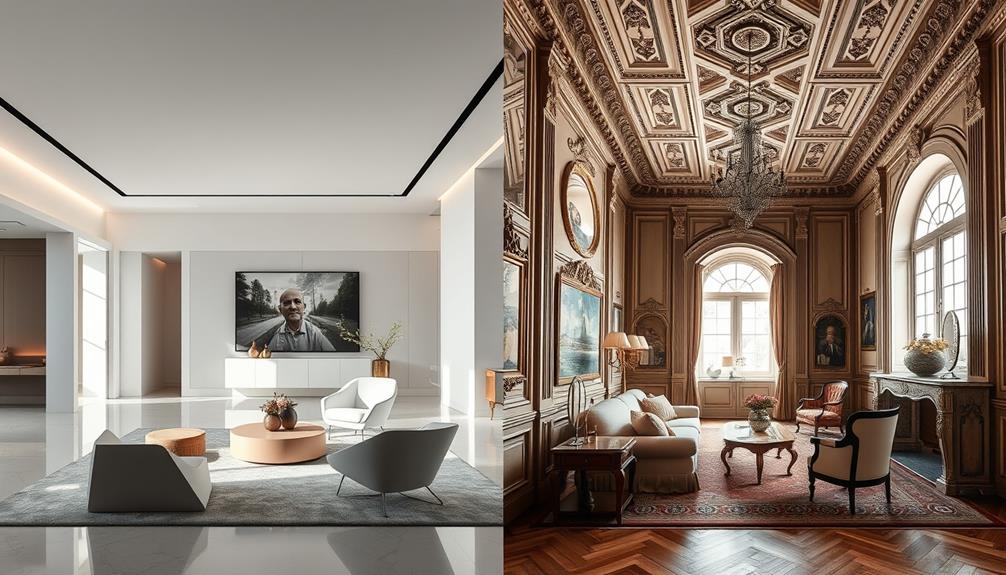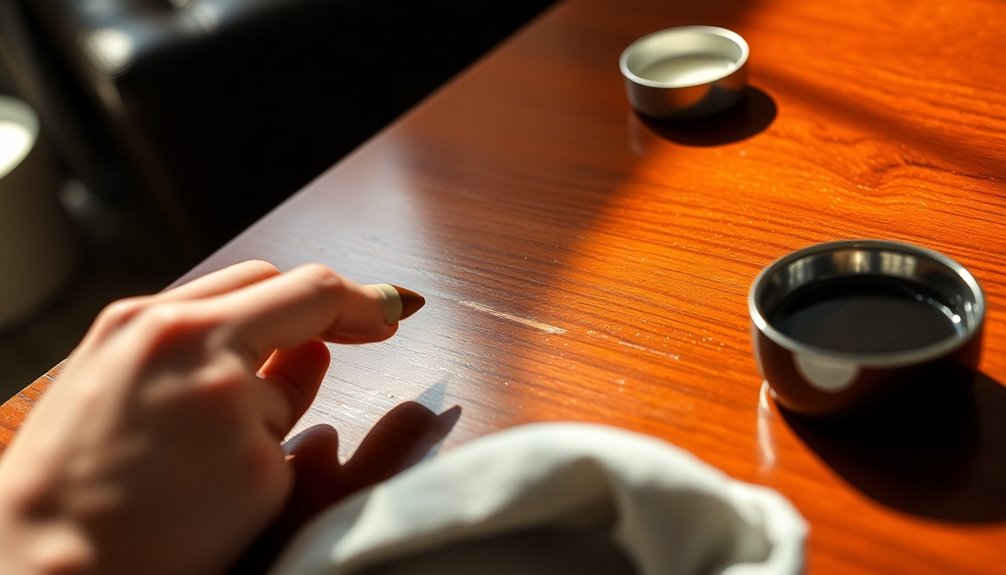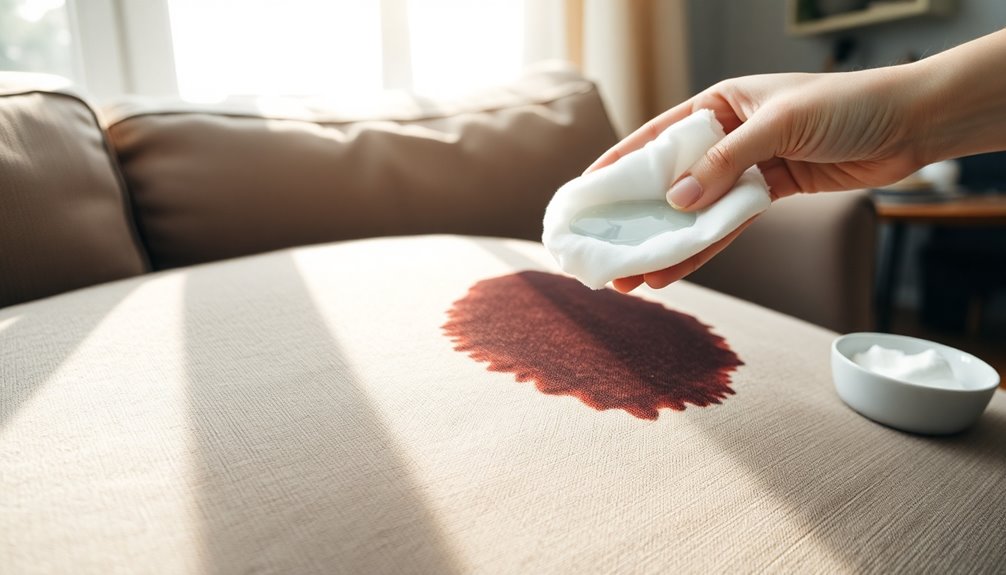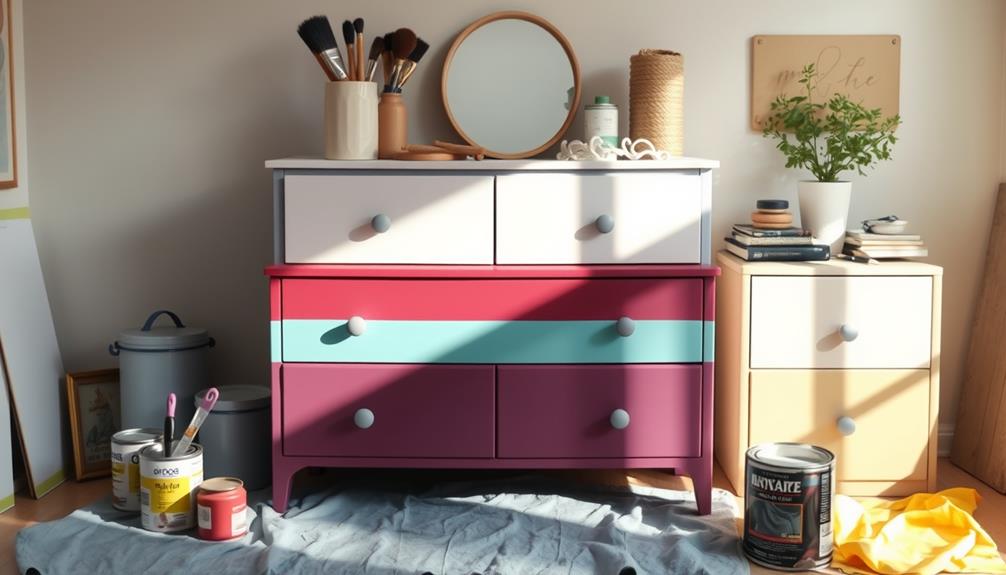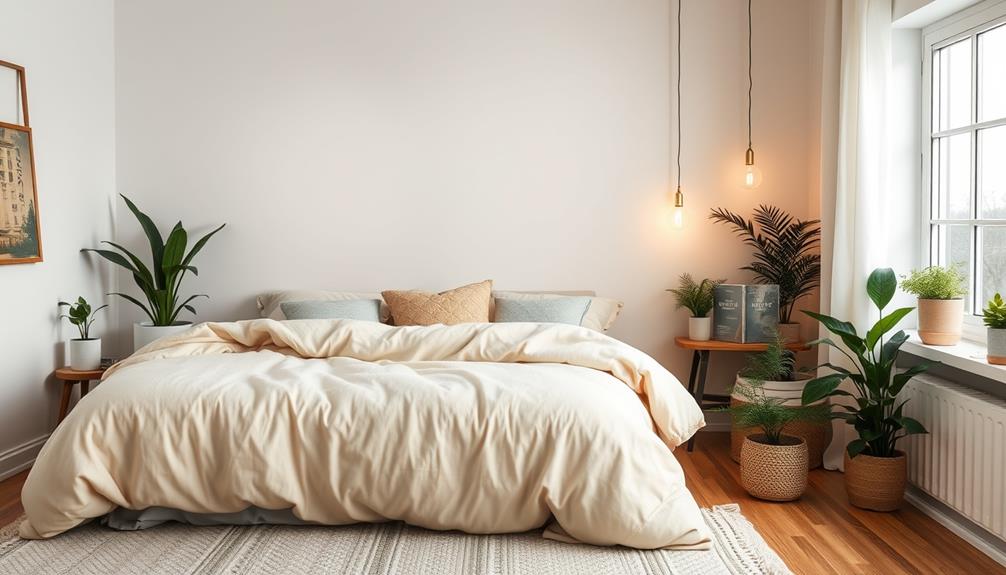In the clash between modern and classic styles, your decision significantly influences the overall ambiance of your space. Classic design is characterized by intricate details and warm hues, cultivating a cozy and welcoming atmosphere filled with rich woods and luxurious textures. On the other hand, modern style prioritizes simplicity and practicality, featuring clean lines and a cooler color scheme. While classic design evokes a sense of history, modern design promotes a sleek and uncluttered aesthetic. Your choice of furniture and color palettes are crucial in defining these contrasting styles. Explore how these elements interact to create unique environments that reflect your personal preferences. Ultimately, when deciding between classic and modern interior design, consider the mood you wish to establish. Whether you are drawn to the timeless sophistication of traditional elements or the efficient minimalism of contemporary styles, both options provide distinct ways to showcase your aesthetic preferences. Combining the two styles can lead to a harmonious fusion, where classic allure meets modern innovation, resulting in a truly personalized space.
Key Takeaways
- Classic style emphasizes ornate details and rich textures, creating warmth and a sense of tradition in interiors.
- Modern design focuses on simplicity, functionality, and clean lines, promoting efficiency and an uncluttered atmosphere.
- Color schemes differ significantly; classic interiors use warm neutrals and deep tones, while modern styles favor whites and sharp blacks.
- The choice of materials impacts the overall feel; classic design uses rich woods and velvet, while modern aesthetics prioritize metals and glass.
- Textures play a crucial role; classic interiors invite touch with intricate textures, while modern spaces emphasize minimalism and visual appeal.
Key Characteristics of Each Style
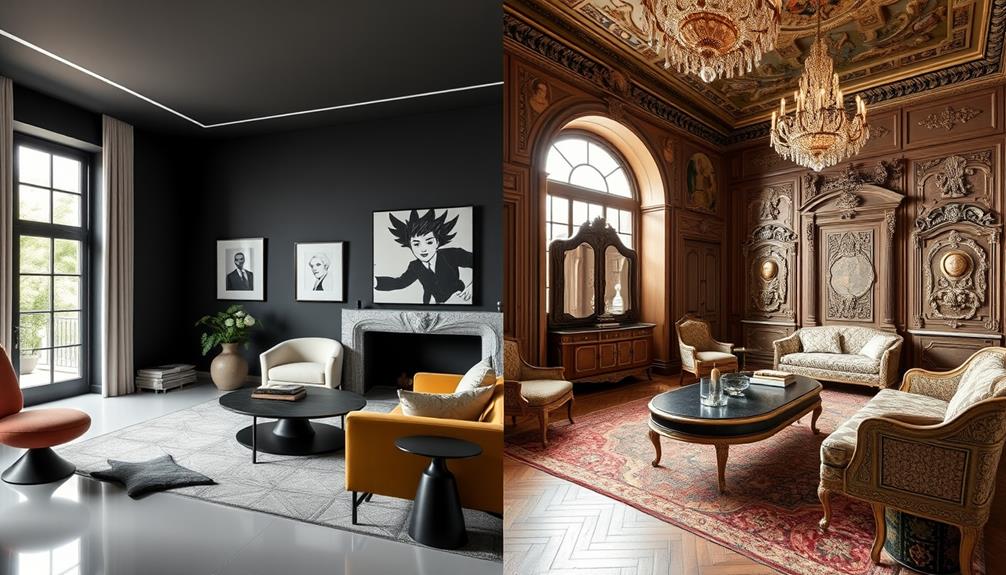
When it comes to distinguishing between modern and classic styles, you'll notice that each has its own unique characteristics.
Classic style features ornate details, rich woods, and warm neutrals, creating a timeless elegance that evokes a sense of history. You'll find deep greens and navy tones adding richness to these spaces.
In contrast, modern design prioritizes simplicity and functionality, showcasing clean lines, geometric shapes, and a palette of whites and cool grays. The emphasis here is on minimalism, where every piece serves a purpose.
Rich textures and intricate elements characterize classic interiors, while smooth surfaces define modern aesthetics. Understanding these key traits helps you appreciate the distinct vibes each style brings to your living space.
Furniture Selection and Impact
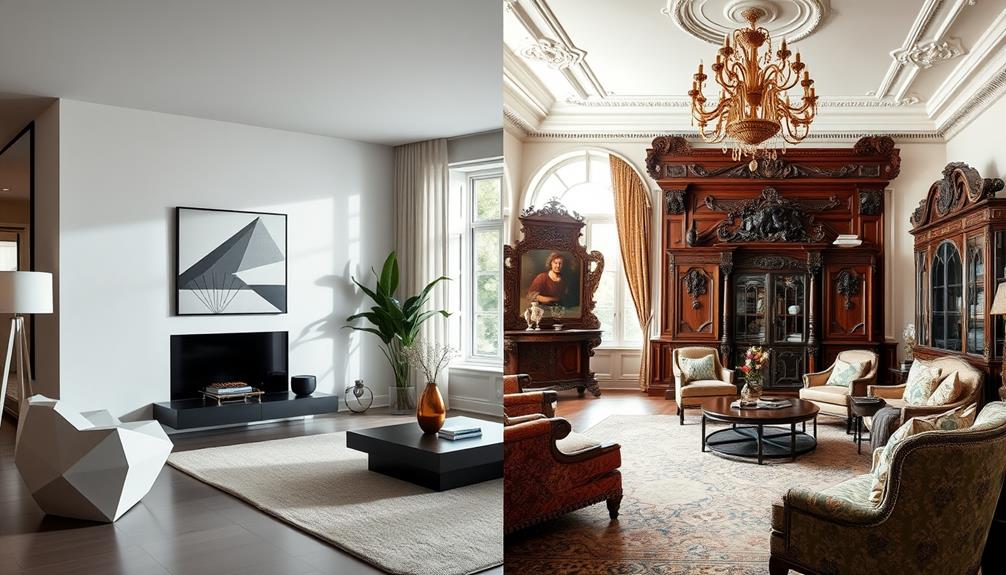
Choosing the right furniture can greatly impact the overall ambiance of your space, shaping the experience of those who inhabit it.
If you lean towards classic style, consider ornate pieces with rich textures and historical craftsmanship. These selections add warmth and a sense of tradition, inviting comfort and elegance.
On the other hand, modern furniture focuses on simplicity and clean lines, promoting a sleek, uncluttered environment. This style fosters efficiency and minimalism, perfect for contemporary living.
By thoughtfully selecting your furniture, you can create a dynamic interplay between styles, blending classic warmth with modern chic.
Ultimately, your choices reflect your personality and set the tone for how others experience your space.
Color Schemes and Their Significance
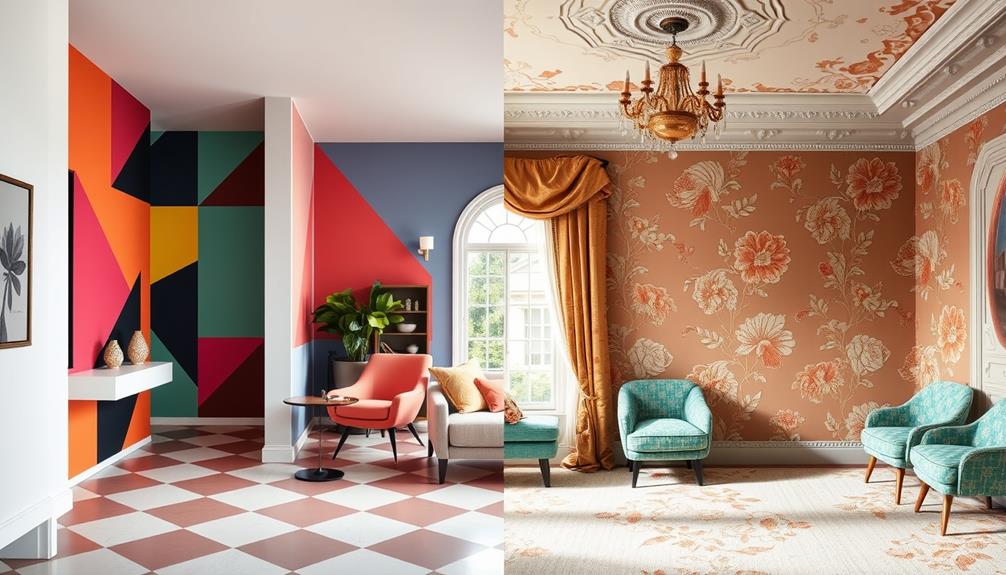
The color scheme in your space plays a pivotal role in shaping its overall atmosphere, much like furniture selection. Choosing the right colors can evoke emotions and set the tone for your environment. Classic designs often utilize warm neutrals and deep tones, creating a cozy, inviting feel. In contrast, modern styles favor clean whites and sharp blacks, promoting a fresh and sleek ambiance.
Here's a quick comparison of color schemes:
| Classic Colors | Modern Colors |
|---|---|
| Warm Neutrals | Clean Whites |
| Deep Greens | Cool Grays |
| Rich Navy Tones | Sharp Black Accents |
| Creamy Beige | Bright Accent Colors |
| Earthy Rich Textures | Minimalist Palettes |
Design Elements and Aesthetics
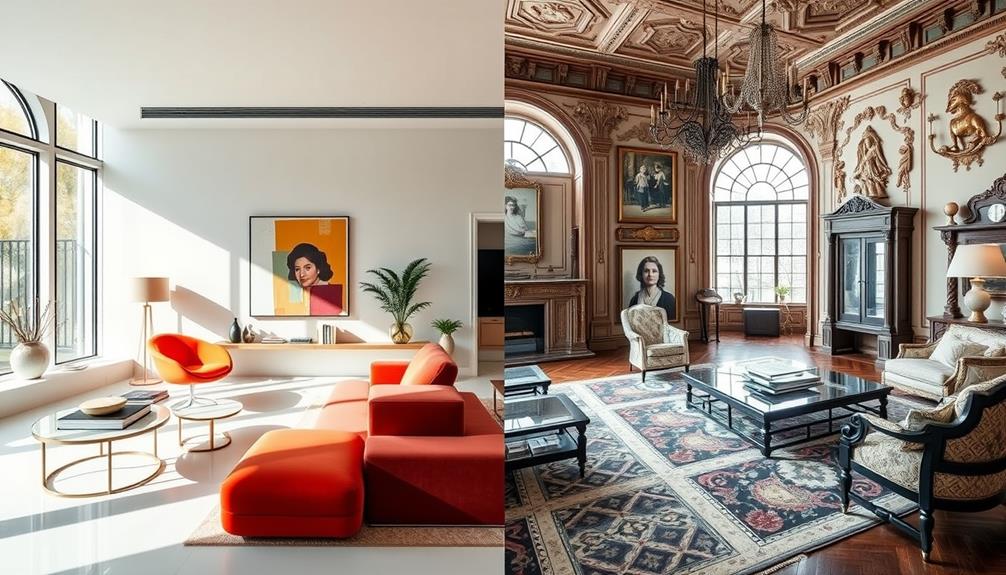
Design elements and aesthetics play an essential role in defining the character of a space, influencing how you experience and interact with your environment.
In modern design, you'll notice an emphasis on clean lines and minimalist aesthetics that create a sense of calm and order. This approach often integrates functionality with beauty, allowing spaces to feel open and inviting while maximizing efficiency, which is a hallmark of effective preparation in design.
You might appreciate the simplicity and functionality that come from this approach, as it often prioritizes efficiency.
On the other hand, classic design invites you to revel in ornate details and historical craftsmanship. The intricate textures and abundant decorations evoke a sense of warmth and richness, making spaces feel inviting and timeless.
Textures, Materials, and Feel
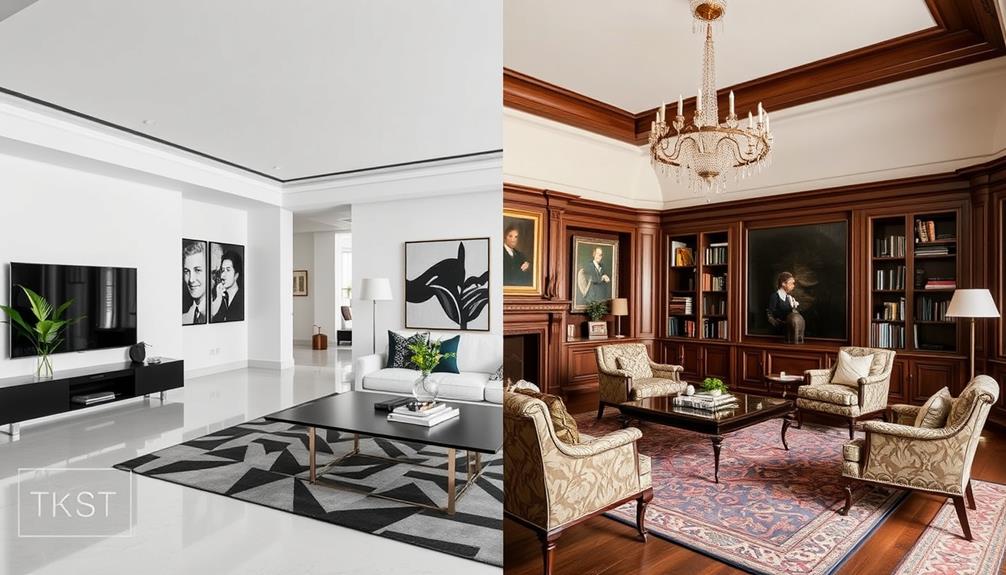
In exploring the textures and materials of classic and modern styles, you'll find that each approach offers a distinct sensory experience.
Classic design envelops you in warmth with rich woods and luxurious fabrics, creating an opulent atmosphere. In contrast, modern design emphasizes sleek surfaces and minimalism, offering a fresh, uncluttered feel.
Here are key differences in textures and materials:
- Classic: Rich woods, velvet, and ornate details evoke nostalgia and comfort.
- Modern: Metals, plastics, and glass provide a clean, functional aesthetic.
- Tactile Experience: Classic textures invite touch, while modern materials often prioritize visual appeal.
These choices greatly influence how you perceive and interact with each style, shaping the overall ambiance of your space.
Frequently Asked Questions
How Do Modern and Classic Styles Influence Cultural Identity?
Modern and classic styles shape cultural identity by reflecting values and traditions. You embrace these designs to express individuality, connect with heritage, and create spaces that resonate with both personal and collective experiences.
Can I Combine Classic and Modern Styles in One Space?
Absolutely, you can combine classic and modern styles in one space! Mix ornate details with sleek lines, layer rich textures against minimalist backgrounds, and create a unique ambiance that reflects your personal taste and style.
Which Style Is More Budget-Friendly to Implement?
Imagine a wise owl choosing between two paths. If you're looking for budget-friendliness, modern style often wins. Its simplicity and minimalism allow you to spend less on furniture and decor while achieving a sleek look.
How Do Lifestyle Needs Affect Style Choice?
Your lifestyle needs directly shape your style choice. If you prioritize functionality and minimalism, you'll lean towards simpler designs. Conversely, if you value tradition and warmth, ornate details will likely resonate more with you. Moreover, mastering semiformal writing style can influence how you communicate these preferences, allowing you to strike a balance between professionalism and a relaxed tone. This style of writing helps convey your ideas clearly while maintaining a touch of sophistication, aligning with how you present yourself through your lifestyle choices. Ultimately, your style—whether in attire, décor, or communication—acts as an extension of your personal values and everyday habits.
What Are Historical Influences on Modern Design?
You'll notice historical influences on modern design stem from movements like Bauhaus and Art Deco. These styles focused on functionality, simplicity, and innovation, shaping how you perceive and interact with contemporary spaces today.
Conclusion
As you stand at the intersection of modern minimalism and classic elegance, think of your home as a symphony. Each style plays its own unique melody, and together, they can create a harmonious tune. Imagine a sleek, modern chair paired with an antique wooden table—this fusion can transform your space into a visual masterpiece. Ultimately, it's about curating a design that resonates with you, blending the old and the new into a sanctuary that feels just right.
